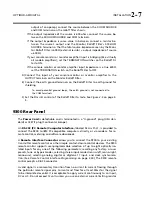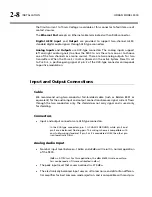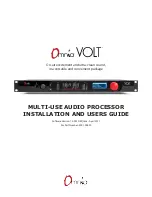
OPTIMOD-AM DIGITAL
INTRODUCTION
1-21
clipper, and transmitter equalization. The negative safety clipper threshold is set to
105% modulation. The positive threshold is determined by the active transmission
preset (see
System Presets and Transmitter Equalization
tings of the highpass filter and transmitter equalizer.
Monitoring
Modulation Monitors and Their RF Amplifiers
Many AM modulation monitors (particularly older ones) indicate dynamic modula-
tion inaccurately even though they may accurately measure sine-wave modulation.
This occurs producing overshoot and ringing. An incorrectly designed modulation
monitor may indicate that modulation is as much as 3dB higher than it actually is.
When modulation monitors are used at locations distant from the transmitter, they
are driven from highly selective RF amplifiers. These sometimes suffer from similar
problems. They can overshoot and ring if the passband filters are too sharp, causing
the monitor to falsely indicate high modulation.
If your modulation monitor does not agree with an oscilloscope monitoring the RF
envelope at the common point, do not assume that the monitor is indicating fast
peaks that your eye cannot see. A probable cause of the disparity is overshoot in the
modulation monitor or its RF amplifier. If you observe this problem, we recommend
that you assume that what you see on the oscilloscope is correct; oscilloscopes are
designed to display pulse waveforms accurately. (Make sure the oscilloscope’s input
is set for DC coupling.)
Note also that modulation percentages will vary depending on where in the trans-
mission system the RF sample is taken. Depending on the location observed, actual
modulation can be either lower or higher than modulation observed at the common
point. What is crucial is whether the carrier is actually pinched off at the final ampli-
fier because this carrier pinch-off is what causes splatter. On the other hand, if the
carrier appears is suppressed because of a particular choice of monitoring point
within the system, negative peaks will fold around zero instead of cutting off. This
causes no problem with out-of-band radiation, and far-field radiation is likely to
show normal AM modulation envelopes. We therefore recommend that you use an
RF sample from the final amplifier.
Monitoring on Loudspeakers and Headphones
Monitor Rolloff Filter
The output of a loudspeaker fed from the modulation monitor typically sounds shrill
and strident because, unlike virtually all real AM radios, the modulation monitor
and loudspeaker have a flat response. Rolloff filtering can be used to supply moni-
tors with audio that more closely resembles that heard over a typical receiver.
Summary of Contents for OPTIMOD-AM 9300
Page 1: ...Operating Manual OPTIMOD AM 9300 Digital Audio Processor Version 2 0 Software...
Page 7: ...Operating Manual OPTIMOD AM 9300 Digital Audio Processor Version 2 0 Software...
Page 178: ...3 46 OPERATION ORBAN MODEL 9300...
Page 200: ......
Page 221: ...OPTIMOD AM DIGITAL TECHNICAL DATA 6 21...
Page 222: ...6 22 TECHNICAL DATA ORBAN MODEL 9300 CONTROL BOARD PARTS LOCATOR...
Page 228: ...6 28 TECHNICAL DATA ORBAN MODEL 9300...
Page 229: ...OPTIMOD AM DIGITAL TECHNICAL DATA 6 29 I O DSP BOARD LEFT AND RIGHT ANALOG INPUTS...
Page 230: ...6 30 TECHNICAL DATA ORBAN MODEL 9300 I O DSP BOARD ANALOG OUTPUTS...
Page 231: ...OPTIMOD AM DIGITAL TECHNICAL DATA 6 31...
Page 238: ...6 38 TECHNICAL DATA ORBAN MODEL 9300 FRONT VIEW REAR VIEW FRONT PANEL PARTS LOCATOR DIAGRAM...
















































